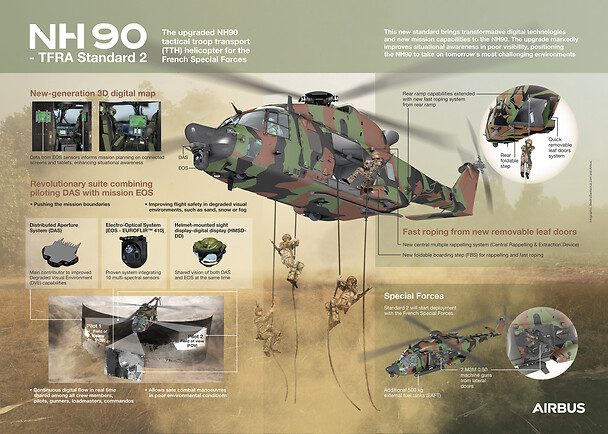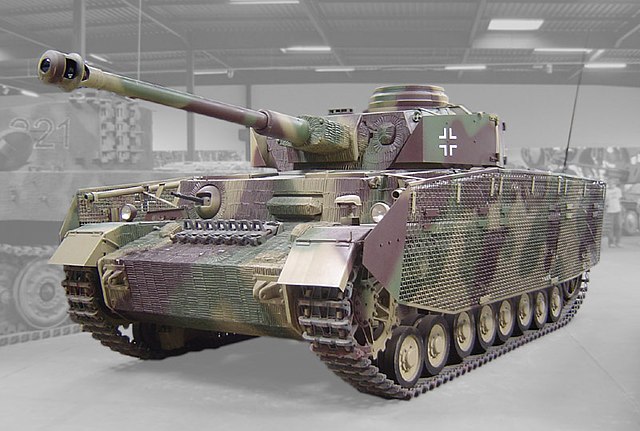
NH90 Cayman TFRA
In such conditions, NH90 Caïman ALAT helicopters operate in North Africa.
One of the main issues raised in the latest white paper on national defense and security of 2013 (Livre blanc de la défense et sécurité national) and included in the Law on Military Programming (LMP, Loi de programmation militaire) for 2019-2025. , defining the tasks of the French Ministry of the Armed Forces (Ministère des Armées), there are guidelines for special forces. The inclusion of these specific units, which are part of the three main branches of the armed forces, among the priorities is a signal of the importance of the forces coordinated by the Special Operations Command (COS, Commandement des opérations spéciales).
The importance of the special units for the French armed forces (Forces armées françaises) has been enormous over the years. Despite the relatively small number of soldiers, not exceeding 4000 people, they play along with military aviation (AEE, Armée de l'air et d'espace) and ground forces (ALAT, Aviation légère de l'armée de Terre) asymmetric actions. In recent years, special forces units have played or are playing an important role in operations in the Levant (Iraq, Syria) and Africa, especially in the Sahel and North Africa and in Libya.
The main task of the Cayman vehicles currently used in Operation Barkhan is the transportation of soldiers.
French "special forces" and their air support
The units that are part of aviation (FSA, Forces spéciales Air) provide both units equipped with aircraft and, in fact, primarily helicopters. One of the transport aviation squadrons - ETOS 3/61 (Escadron de transport d'opérations spéciales) Poitou, equipped with C-160F Transall, C-130H Hercules medium vehicles and DHC-6 Twin Otter light vehicles, is deployed at the base of BA 123 Orléans - Brisi . The squadron is complemented by a helicopter unit - EH 1/67 (Escadron d'hélicoptères) Pyrénées from the BA 120 Commandant Marzac base in Casot, equipped with H225M Caracal rotorcraft. Currently, the basic organizational unit is the Special Purpose Air Brigade (BFSA, Brigade des Forces spéciales Air), created on September 1, 2020, to which ETOS 3/61 and EH 1/67 are subordinate. Special Operations Command (COS) also controls the 4th Special Forces Helicopter Regiment (RHFS) from Pau, seconded from ALAT, with various types of vehicles (Puma / Cougar /
/ Caracal, Tigr HAP, Gazelle).
In 2014, the Air Force of the ground forces for the first time involved in combat operations in the Sahel and Sahara (BSS) Sahelo-Sahara strip (BSS) the latest multi-purpose helicopters NH90 Caïman TTH (Tactical Transport Helicopter). For the current operations of Operation Barkhan, this meant a significant increase due to the possibility of using a rotorcraft with greater autonomy, maneuverability and payload, exceeding the capabilities of the Puma and Cougar machines used so far. At that time, under the applicable 2014–2019 LPM, it was decided to acquire six additional Caïmans, which was to allow for a more flexible organizational structure. The then commander of COS, General Gregoire de Saint-Quentin, said that for the further effective conduct of special operations, another 24 NH90 helicopters would be required, which should reach the line within 15 years. Basically, it was about unifying the fleet by replacing Puma and Cougar rotorcraft with 4e RHFS, which would not only bring advantages in the field of logistics and training, but also increase the operational capabilities of COS units. In 2014, the regiment was equipped with 23 medium multirole helicopters of three types (nine Caracalis, five Cougars and nine Pumas). According to General de Saint-Quentin, only Caïman helicopters should remain in the equipment of this unit, although these machines were not developed for use in support of special forces. According to him, the NH90 adapted for these purposes should have great surveillance capabilities, especially in the forward hemisphere, thanks to an optoelectronic head with a long-range thermal imaging camera, which would also facilitate piloting without direct visibility of the terrain, at night, and also in the presence of significant dust. The helicopters will also receive an extensive set of weapons, including those suspended from pylons mounted on both sides of the fuselage. The general, however, correctly diagnosed the situation that the implementation of these plans could be hampered by the high costs of purchasing and adapting the Cayman machines to new tasks, and the adaptation would certainly be lengthy.

